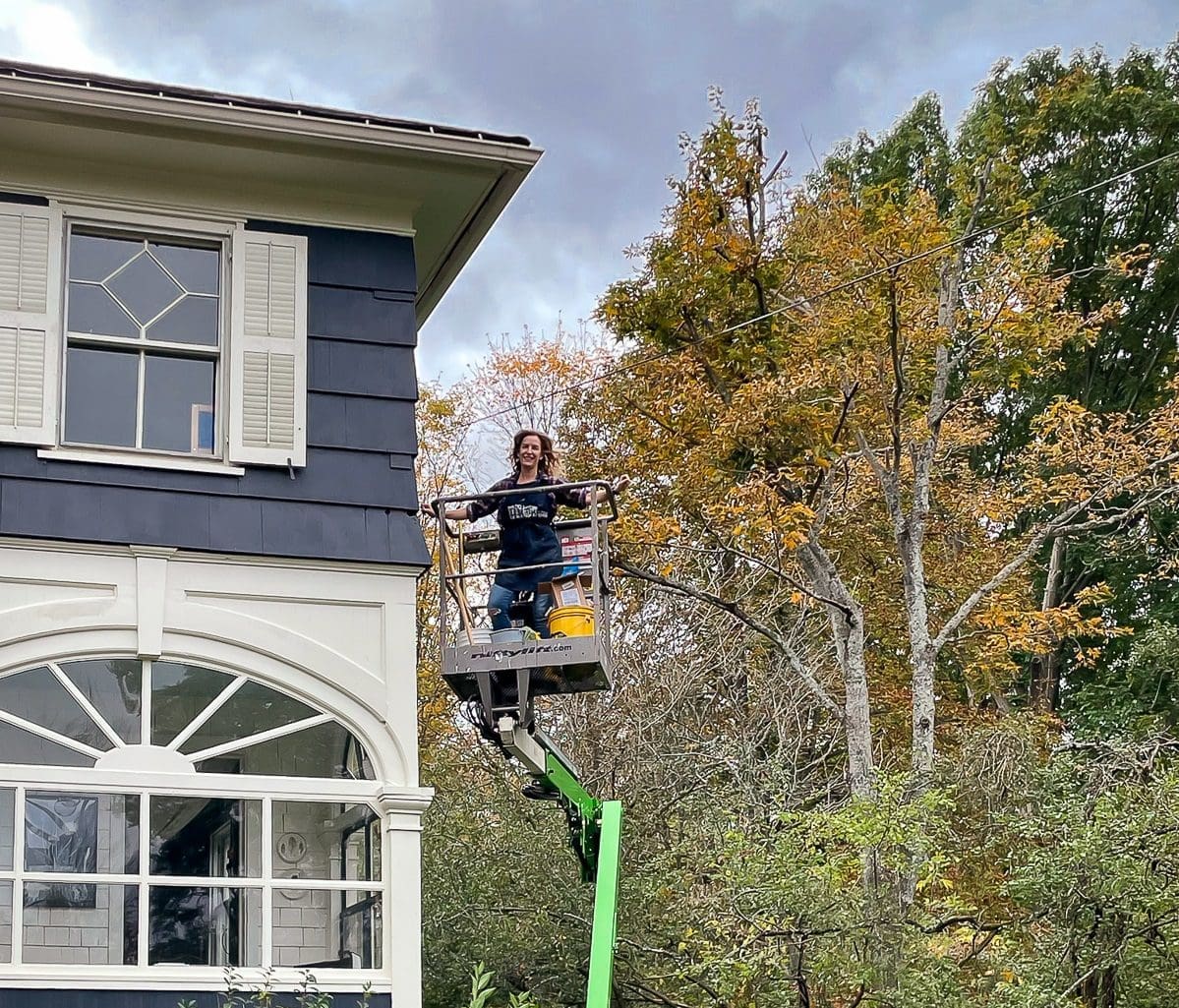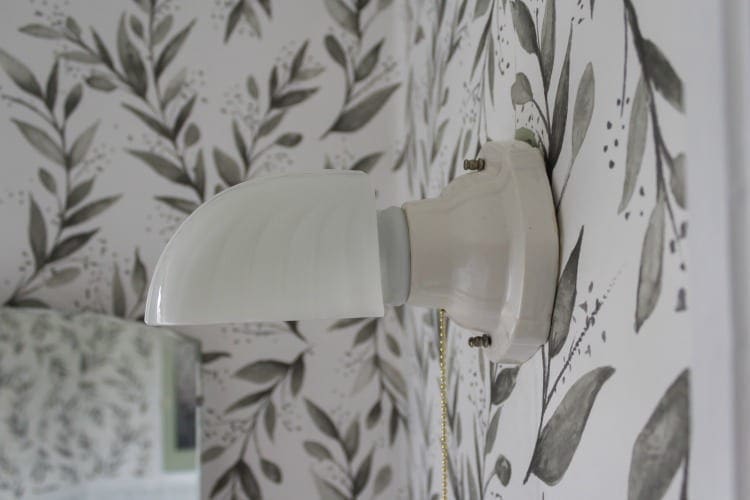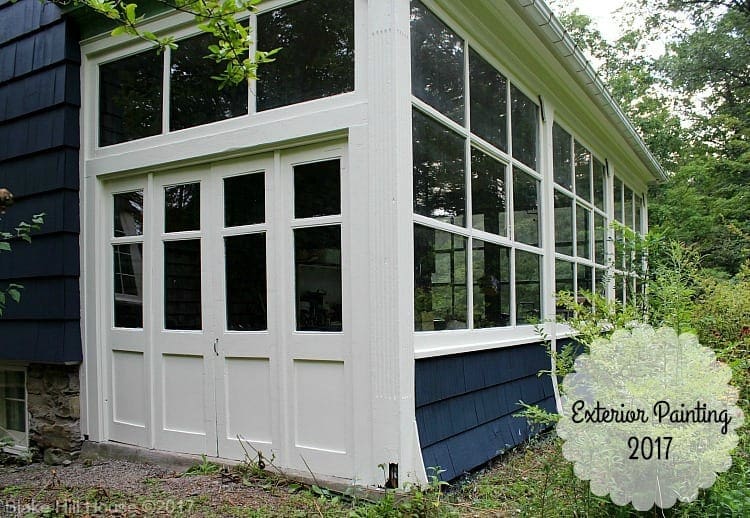Alternate title: I’m the queen of the world! Second alternate title: Terrifying people who are scared of heights. On the podcast Monday, I mentioned that I was going to rent a boom lift. That happened this past weekend. Before I picked up the lift, I made an extensive list of what I hoped to accomplish over a two-day rental. My goals were way too lofty as usual, but the plan was to do as much work as possible and pick it back up in the spring. Maintaining the exterior of an old house, or even a newer one, should be part of seasonal chores, but I admit we had not done nearly enough in the past seven years. I can’t move the ladder around by myself, and it’s hard to pin down more people to help.
My fall chore list:
- Fill woodpecker holes
- Clear the downspouts and gutters
- Inspect the soffets and fascia for rot and poor paint condition
- Wash windows
- Paint the downspouts
- Remove the shutters from the bathroom windows and install the wood storm windows on hangers.
- Remove abandoned bird and wasp nests
- Scrub bat poop off the siding. (They love sleeping behind our shutters!)
- Repair the stone foundation – no lift required (I made a video about the process last year.)
This post contains affiliate links.
Maintaining the Exterior of an Old House is More Fun with a Boom Lift
My local rental store had several lift options, but I chose the Nifty Lift that I could tow with my small SUV. Our experience got off to a rocky start because I didn’t read the website correctly. I thought the lift was self-driving. However, it only moves when it is towed. So, I took my extensive to-do list and set it on fire. Although I could reach some of the serious trouble spots, I could not drive the lift all the way around the house due to the soft ground and a deep ditch. The rental location has different options when we rent in the spring, but we can also prep the ground and use the towable lift again.

I love heights. Love them. That said, the fully extended arm was a little bouncy, which took some getting used to. Since coming up and down was a bit of a chore, I loaded up the basket with everything I thought I might need. Even so, I had to keep texting Andy to bring me things I forgot or toss supplies that I dropped. He’s got a good arm. Teamwork makes the dream work.


Filling Woodpecker Holes
During our first four years here, we had a new roof put on the house, and we also had the house painted. Then, the woodpeckers arrived and began to destroy the siding shingles on the west side of BHH. Honestly, I didn’t even notice it was happening until I moved my office to that side of the house. Then, the constant tapping tipped me off. That’s when Operation Woodpeckers Must Go began. Now, I run outside to scare them away whenever I hear them. Coincidentally, I do the same for deer. The deer are freaking everywhere.
Living in a Disney movie might sound fun. However, coexisting with mismanaged wildlife that is also experiencing a population explosion is less dreamy than it seems. In my neighborhood, even the three-legged doe looks like a hot date, and she has given birth to twins two years in a row.
I swear I am not a horrible person. I’ve lived in or near national parks for almost my entire life, and the grumpiest animals are supposed to win. That’s how we stay in balance. We observe and enjoy each other from afar.

Back on topic: Woodpeckers typically only do damage where insects are present, so we’ve been paying for quarterly exterior pest service for three years. I am not a fan of chemicals (writes the mom who rejected everything when her kids were small), but the amount of critters that make it their mission to destroy BHH is alarming. Seriously, we have a long winter, but once warm weather arrives, the pests roll up their tiny sleeves and get to work. We have at least three types of nuisance ants plus carpenter ants, carpenter bees, yellow jackets, European hornets, stink bugs, some other beetle thing, and woodpeckers. BHH also becomes a nursery for squirrels, ground chipmunks, and nesting birds if there are any open gaps or crevices.
Using a pest service reduced the amount of woodpecker damage. Then, after we removed three dead ash trees last fall, the activity cut down even more.
To make the repairs, I cut a bunch of different-sized dowels of varying thicknesses. Then, I filled the holes as much as possible.

I used a dab of liquid nails on the end, and for the larger pieces, I shot a finishing nail into the center.

I filled the rest of the gaps with wood epoxy. For this project, I used the warm weather slow cure formula from Next Generation Systems.

Is this the right way? I don’t know. It is one way. BHH has about four layers of siding shingles, so I was not gluing or nailing anything into the sheathing. Repairing the woodpecker holes with dowels and epoxy seemed like a no-harm solution. I’ll keep my eyes open for some replacement shingles to keep on hand if replacing an entire shingle would be more cost-effective. One of these days, I’ll write a post about the difference between epoxy and wood filler. However, in the meantime, I want to add that wood filler or wood putty would not be the best long-lasting choice for this type of repair. It could eventually shrink, and moisture would infiltrate the siding creating the perfect scenario for rot.
After the epoxy dried, I painted it, and no one will ever see those repairs from a trotting horse. (Shout out to my friend Holly for teaching me that saying. For low stakes projects, I now ask myself, “Will anyone see that from a trotting horse?”)
Downspouts and Gutters

Our gutters are not nearly large enough to handle all the rainwater we get, and the roof is over 22 feet high. I cleared the downspouts I could reach, and we will have to drag out the dreaded ladder for the rest. One thing I plan to add next spring is leader heads. They are so common in the UK, and I don’t know why we don’t use them more here in the United States.
Leader heads (called hopper heads in the UK) are large metal boxes, open at the top, with a drain that fits right into a downspout. They are secured to the house just below the elbow. They are often quite pretty too. Leader heads help manage high volumes of rainwater drainage by simply holding more and creating a funnel, allowing gravity to shoot runoff through the downspout faster. I am still looking for some that are reasonably priced and look nice too.
A project I actually did finish was painting our downspouts. That’s a task that could have possibly been filed under Things that Maybe only Stacy Notices, but I couldn’t unsee the white against the blue. May I direct your attention to the right side of the photo below?

Seeing those downspouts painted the same color as the house has made me happier than I probably should be. (Ignore the white extensions on the ground. I’ll swap those out soon.)

The other side of the house had a very noticeable white downspout too.
Before:

After:

Yessss. Now, if I could just go back in time and move the electrical service drop to a less intrusive location. Maintaining the exterior of an old house always includes wishing for a few do-overs.
Removing the Shutters from the Bathroom Windows
Removing the shutters may be controversial, but let me explain. A few months ago, I wrote a post about shutters. In that post, I offered a brief history of shutters and how shutters and wood storm windows typically did not coexist during the same period.
Most of our storm windows are aluminum triple-tracks, but we do have a handful of original wood storms, and two of them are on the bathroom windows on the second floor. The storms were nailed in place, and I wanted to put them on hangers so we could open them for fresh air and moisture management.

Unfortunately, I did a terrible job documenting this process because it was completely dark at this point. I had been working the better part of two days straight, and I was ready to be done. I had to remove the shutters to hang the storm windows because the shutter hardware was in the way. Getting that hardware off was a real pain. The slotted screws were coated with paint (#oldhouseproblems), and I somehow lost the slotted screw bit for my impact driver. During this final project, my sweet swear word substitutes became real swear words.
I was only able to complete one side because I was cranky and tired by the time I finished on the right, and did I mention it was dark? I felt like I might start making stupid mistakes, so I called it a day. Safety first!
Next spring, I’ll finish the left side and complete the finish work on the right. Speaking of the left side, the diamond sashes are currently in my workshop getting a makeover.

Other Tasks
For everything else on the to-do list, I tackled it as I was completing other projects. I dabbed a little paint here and there, washed the bird and bat poop off, and even changed the floodlight bulbs on the front of the house. I forgot one was burned out, but I put new bulbs in both. The abandoned bird and wasp nests are located on the side of the house that I couldn’t reach, but I will remove them next spring after mom kicks out her baby birds. I’m not a monster.
Foundation repairs do not require the boom lift, so I’m plugging away at that task on the nice weather days.
If you are maintaining the exterior of an old house too, here are some other items you might put on your fall chore list:
- Roll up garden hoses and put them away
- To avoid mildew and rot, trim bushes and tree branches so they are not resting against the siding or foundation – Be sure to research the healthiest time to prune. Some plants should be pruned in the spring vs. the fall and vice versa.
- If you live in a cold climate, locate your snow shovels, service the snowblower, and put a container of ice melt where you need it.
- Sweep out chimneys and make sure the chimney caps are in good condition. I have done this as a DIY project before, but I recommend calling a pro for first-time maintenance. A pro can also give your fireplace a thorough inspection.
Where I live, winter is frigid. However, I know some of you live in much milder climates. Please let me know what maintaining the exterior of your old house looks like where you live, and I will add those tasks to the list.
Next Steps
Due to the backlog, I think we will have to rent a boom lift twice in 2022 and probably once per year after that. If the leader heads solve our downspout issues, a yearly rental may not be necessary. I’ll keep you posted. Maintaining the exterior of an old house is a heckuva lot easier and safer with the lift, and it makes the projects more fun too.






14 Comments
RZ
Good work! What did you use for cleaning up your bat poop? I need to do this too, and am pondering whether it needs a real disinfectant, or whether mere dish soap will suffice.
Stacy
Thank you! I just used water and dish soap. I was concerned about something harsher removing paint or creating shiny spots, and I didn’t feel like disinfectant was necessary. Next year, I want to soft wash the entire house, and then I will repaint a few key areas.
Chris
For those of us in super mild climates, in prep for “winter,” I consider whether it is still too soon to plant lettuce seeds (today’s high – 89), tear out the last of the tomatoes and generally prep the garden for leafy greens, flowers, and a fallow period. Lay down a new layer of mulch. Find or replace the styrofoam covers for my hose spouts in case we get a hard freeze this year. Do the 3 month checks on the generator and chain saw. Generally those are hurricane tools, but ice storms do happen every few years. Every few weeks mow the leaves into particles so that the grass doesn’t die. Feed the fig tree (and any other fruiting trees and bushes) and prune the roses a couple of weeks before thanksgiving so that I’ll have roses for thanksgiving. … It’s very different living in a place without snow.
Stacy
Thanks, Chris. Great tips. So, are there any exterior-specific projects that you do seasonally? Do pests invade your siding or windows? What do you deal with regularly?
Chris
We have a pest control company come out regularly to spray and we have these in ground things around the house because wood ants and termites are both serious problems. Wasps nest in the eaves and the bushes and in the hole into the attic where the electric drop goes in, ants crawl in at the foundation and the attic eaves, tree roaches come in the same way. On the plus side, window gekko crawls out of the ornamental grass every evening and catches moths on my window screen. 🙂 I live just north of Houston, so for us “fall” means leaves fall down and need to be removed from the driveway and mowed into particles on the lawn, and the grass doesn’t need cutting more than every 6 weeks or so. It’s a good time to power wash the algae off any siding that doesn’t get sun, and clean the grill in prep for fall and winter grilling. Remulch the plants, and pull any that are past bearing fruits/flowers. Feed the trees & bushes. Honestly, the big exterior project time for me is late Jan/Feb and into March. Cleaning up the winter debris, setting up gardens, pruning all the bushes back, sidewalk and driveway repair, and any new garden building that needs doing before it gets too hot. The next big flurry is at the start of hurricane season, evaluating the tall trees, making sure that the chainsaw and generator are in working order, and pruning away any branches that overhang the house. Seriously, an ice cold day in winter here means it dipped below 50.
Stacy
Thanks, Chris. 🙂 You’re describing the same weather we had when we lived in Central California.
Jeri
I have to agree that the white downspouts would have annoyed the heck out of me also if BHH was mine. I laughed out loud that you got more satisfaction than you should have from completing that particular project. Been there done that myself with some projects. It just shows that you are a very visual and orderly person!!!!! If offened your personal aesthetics everytime you saw them.!!!!!
Keep up the great work. PS We use a silicon outdoor caulk for the woodpecker holes…no shrinkage.
Stacy
Every time I pulled up to the house, I saw those white downspouts. Ha! Thank you for sharing my enthusiasm for the task. 🙂
Regarding caulk, it may not have shown in the photos, but most of our woodpecker holes were over an inch in diameter!–too large to fill with caulk.
Jeri
Stacy many of our woodpecker holes were also 1″ big….lots of silicone caulk and putty knife to smooth out.
Sherrill
Is there nothing that will stop you? That is a clever way to fill the woodpecker holes and I much prefer the painted downspouts. In researching the history of our 110 year old house I saw a pattern of owners aging in place until they could no longer do the maintenance and selling the house as a fixer. The new owner brought new enthusiasm and made the repairs. Now we are those old people and I did not want to repeat the process, so I’m pleased to say we hired out the repairs this year.
Stacy
I try to be unstoppable, Sherril. 🙂 I 100% support that you hired someone to do this work.
Nancy
Give your utility company a call because in our area, any utility box, including pipes or cables that are attached to your house (water or electric meters) are the property of the homeowner & can be painted whatever color you wish. Just leave the viewing window or bubble unpainted. Propane and other tanks can often also be painted, but it’s wise to check w/ the supplier first on those. Love the blue downspouts!
Andrea Matters
SO MUCH BETTER with the painted downspouts! Recently I saw a new build, all farmhouse white with black windows and black trim. There were downspouts all over the place: at every corner of the house, in the middle of side elevations, and even down the sides of decorative porch columns, and they were all ebony black. It looked like a toddler had outlined the house with a Sharpie, or like Donald Trump was trying to forecast the weather. I love BHH with downspouts painted to match the shingles!
Stacy
Thanks, Andrea. I think it makes a world of difference too. I have more to paint next summer, but tackling the most visible ones first made a big impact.
LOL about a house outlined with a sharpie!